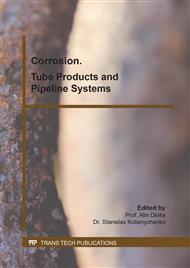p.3
p.10
p.16
p.22
p.28
p.33
p.41
p.47
p.54
Studying of Causes of Destruction of the Main Gas Pipeline
Abstract:
In the territory of the Russian Federation within a year, in connection with change of atmospheric conditions, the soil moisture content, saturation of its different layers, temperature and a physical status of soil changes. Depth of freezing of soil is much lower than the bottom level of the pipeline. Freezing, defrosting and uneven rainfall of soil are adverse factors in these conditions. Apparently from the above, there are conditions of forming of corrosion cracking energized (CCE) connected with seasonal and long-term variability of water content of soil. At the same time manifestation of specific features of CCE, characteristic of the specific region, is possible. For studying the reasons and the nature of destruction of the main gas pipeline, in this work a studying of a focal zone is carried out. When determining stress corrosion cracking, first of all, the attention to existence of a fragile component in a break, arrangement of fragile cracks in the lower half-perimeter of a pipe and orientation of the fragile cracks along the forming pipe, which are the main signs of manifestation of corrosion cracking, was paid. On the basis of the received results it is proved that the studied cracks have the corrosion and mechanical origin, characteristic of corrosion cracking energized. Actions for prevention of destruction of gas pipelines are offered further.
Info:
Periodical:
Pages:
28-32
Citation:
Online since:
May 2020
Authors:
Price:
Сopyright:
© 2020 Trans Tech Publications Ltd. All Rights Reserved
Share:
Citation:



